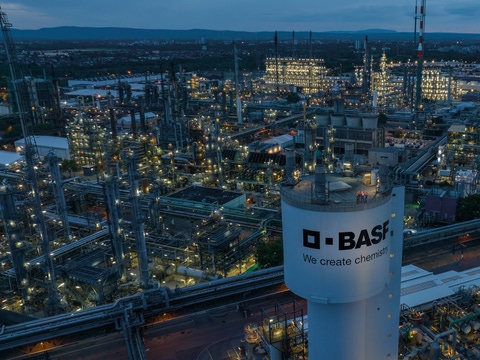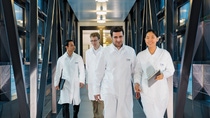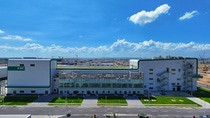BASF in Greater China 2023
The BASF Group
At BASF, we create chemistry for a sustainable future. We combine economic success with environmental protection and social responsibility. Around 112,000 employees contribute to the BASF Group’s success worldwide. Our business comprises the Chemicals, Materials, Industrial Solutions, Surface Technologies, Nutrition & Care and Agricultural Solutions segments.
BASF Group
2023 – At a glance

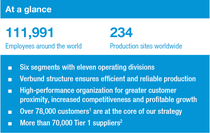
At BASF, we create chemistry for a sustainable future. We combine economic success with environmental protection and social responsibility.
Our customer portfolio ranges from major global customers and small and medium-size enterprises to end consumers in nearly all sectors.
Segment data

The segment supplies BASF’s other segments and
customers with basic chemicals and intermediates.

The segment offers chemical solutions for surfaces and automotive coatings, as well as battery materials and catalysts.

The segment offers advanced materials and their precursors for the plastics and plastics processing industries.

The segment produces ingredients and solutions for consumer applications such as human and animal nutrition, and home and personal care.

The segment is an integrated provider of seeds, crop protection and digital solutions for the agricultural sector.

The segment develops and markets ingredients and additives for industrial applications.
Sites and Verbund
As one of the world’s largest chemical companies, BASF is present in 93 countries. We operate 234 production sites worldwide. We laid the foundation for the Verbund concept in Ludwigshafen, Germany, in 1865 – and it remains one of our key strengths to this day. Intelligently linking and steering our Verbund plants creates efficient value chains – from basic chemicals to high value-added solutions. The Verbund enables us to manage our production in a resourceefficient, carbon-optimized and reliable way. By-products from onefacility are used as feedstocks elsewhere, for example. This saves raw materials and energy, avoids emissions, lowers logistics costs and leverages synergies.
![Steam cracker II, the largest individual plant at BASF's Ludwigshafen site, covers a surface area of about 64,000 square meters, which is about the size of 13 soccer fields. The steam cracker is also the heart of BASF's Verbund production strategy. This giant plant has been operating since 1981 and uses steam to crack naphtha at about 850°C [1,562°F]. This process leads primarily to ethylene and propylene, both indispensable feedstocks for manufacturing numerous products in Ludwigshafen. Steam cracker II, the largest individual plant at BASF's Ludwigshafen site, covers a surface area of about 64,000 square meters, which is about the size of 13 soccer fields. The steam cracker is also the heart of BASF's Verbund production strategy. This giant plant has been operating since 1981 and uses steam to crack naphtha at about 850°C [1,562°F]. This process leads primarily to ethylene and propylene, both indispensable feedstocks for manufacturing numerous products in Ludwigshafen.](/api/imaging/focalarea/16x9/210x/dam/jcr%3A3e21294a-f663-3db3-9f41-686056b51abd/1.4.jpg)
Steam cracker at BASF's Ludwigshafen site
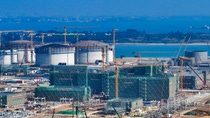.jpeg)
BASF Zhanjiang Verbund site (in construction)
In addition to Ludwigshafen, Germany, BASF operates five other Verbund sites in Antwerp, Belgium; Freeport, Texas; Geismar, Louisiana; Kuantan, Malaysia; and Nanjing, China. Another Verbund site is being built in Zhanjiang in the southern Chinese province of Guangdong. Following the startup of the engineering plastics plant in 2022, a plant for the production of thermoplastic polyurethanes came onstream there in 2023.
Organization of the BASF Group

This segment structure enables us to steer our businesses according to market-specific requirements and the competitive environment. We provide a high level of transparency around the results of our segments and show the importance of the Verbund and value chains to our business success. The operating divisions, the service units, the regions, research and development and the corporate center are the cornerstones of the BASF organization. This organizational structure lays the foundation for customer proximity, competitiveness and profitable growth. BASF aims to differentiate its businesses from their competitors to enable BASF to perform even more strongly in an increasingly competitive market environment.
The divisions bear strategic and operational responsibility and are organized according to sectors or products. They manage the 49 global and regional business units and develop strategies for 70 strategic business units.
Procurement and Sales Markets
BASF supplies products and services to over 78,000 customers1 from various sectors in almost every country in the world. Our customer portfolio ranges from major global customers and small and medium-sized enterprises to end consumers.
We work with over 70,000 Tier 1 suppliers2 worldwide. They supply us with important raw materials, chemicals, investment goods and consumables, and perform a range of services. Important raw materials (based on volume) include naphtha, liquid gas, natural gas, benzene and caustic soda.

1 The number of customers refers to all external companies (sold-to parties) that had contracts with the BASF Group in the business year concerned under which sales were generated.
2 BASF considers all direct suppliers of the BASF Group in the business year concerned as Tier 1 suppliers. These are suppliers that provide us with raw materials, investment goods, consumables and services. Suppliers can be natural persons, companies or legal persons under public law.
Business and Competitive Environment
.jpg)
BASF’s global presence means that it operates in the context of various local, regional and global developments.
These include:
- Global economic and political environment
- Legal and political requirements
- International trade agreements
- Industry standards
- Environmental agreements (e.g. E.U. Emissions Trading System)
- Social aspects (e.g. U.N. Universal Declaration of Human Rights)
BASF holds one of the top three market positions in around 80% of the business areas in which it is active. Our most important global competitors include Arkema, Bayer, Celanese, Clariant, Corteva, Covestro, Dow, DSM-Firmenich, Evonik, Huntsman, SABIC, Sinopec, Solvay, Syngenta, Wanhua and many hundreds of local and regional competitors. We expect competitors from Asia and the Middle East in particular to continue to grow in significance in the years ahead.
Corporate Legal Structure
As the publicly listed parent company of the BASF Group, BASF SE takes a central position: Directly or indirectly, it holds the shares in the companies belonging to the BASF Group and is also one of the largest operating companies. In the BASF Group Consolidated Financial Statements, 260 companies including BASF SE are fully consolidated. We consolidate nine joint operations on a proportional basis and account for 21 companies using the equity method.
For more information on the companies belonging to the BASF Group, see basf.com/en/corporategovernance
